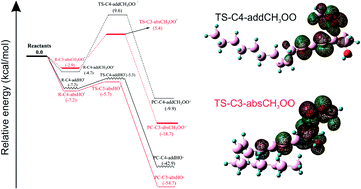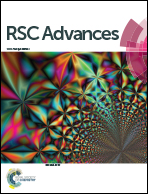A DFT analysis on the radical scavenging activity of oxygenated terpenoids present in the extract of the buds of Cleistocalyx operculatus†
Abstract
The antioxidant capacity of twenty-one oxygenated monoterpene and oxygenated desquiterpene compounds in the extract from Cleistocalyx operculatus has been computationally evaluated. Calculated by (RO)B3LYP/6-311++G(2df,2p)//B3LYP/6-311G(d,p) model chemistries, the thermochemical parameters, namely BDE, IE, PDE, PA and ETE in the gas phase, water and ethanol were determined. In addition, quantum descriptors, which allow the evaluation of the reactivity and stability of the resulting radicals like chemical potential (µ), hardness (η) and global electrophilicity (ω) were also computed. Potential energy surfaces of the reactions between CH3OO˙ and HO˙ radicals with falcarinol and α-vetivone, two typical and potential antioxidant molecules, were established to give more insight into the antioxidant mechanism. The obtained results underline falcarinol as the most effective antioxidant with the lowest BDE of 66.5 kcal mol−1 and PA of 341.3 kcal mol−1 in the gas phase. Among the reactions on falcarinol, the H-abstraction at C3–H position by both CH3OO˙ and HO˙ radicals are favorable with the energy barriers of −18.7 and −54.7 kcal mol−1, respectively. Moreover, NBO analysis helps to clarify the mechanism of antioxidant action which shows that the third lone pair of electrons on O1-atom of CH3OO˙ radical is donated to an unoccupied σ*-antibonding orbital on C3–H, and on the C4![[triple bond, length as m-dash]](https://www.rsc.org/images/entities/char_e002.gif) C5, C6
C5, C6![[triple bond, length as m-dash]](https://www.rsc.org/images/entities/char_e002.gif) C7 triple bonds. Similarly, attack of CH3OO˙ and HO˙ radicals on α-vetivone demonstrates that H-abstraction reactions are also more feasible than the addition ones with ΔH values of −7.3 and −41.9 kcal mol−1, respectively. For all considered reactions, the antioxidant molecules preferentially interact with HO˙ radical.
C7 triple bonds. Similarly, attack of CH3OO˙ and HO˙ radicals on α-vetivone demonstrates that H-abstraction reactions are also more feasible than the addition ones with ΔH values of −7.3 and −41.9 kcal mol−1, respectively. For all considered reactions, the antioxidant molecules preferentially interact with HO˙ radical.



 Please wait while we load your content...
Please wait while we load your content...